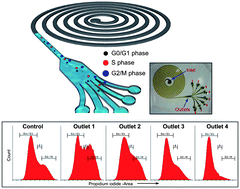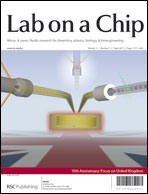High-throughput cell cycle synchronization using inertial forces in spiral microchannels†
Abstract
Efficient synchronization and selection of cells at different stages of the cell replication cycle facilitates both fundamental research and development of cell cycle-targeted therapies. Current chemical-based synchronization methods are unfavorable as these can disrupt cell physiology and metabolism. Microfluidic systems developed for physical cell separation offer a potential alternative over conventional cell synchronization approaches. Here we introduce a spiral microfluidic device for cell cycle synchronization, using the combined effects of inertial forces and Dean drag force. By exploiting the relationship between cell diameter and cell cycle (DNA content/ploidy), we have successfully fractionated several asynchronous mammalian cell lines, as well as primary cells comprising bone marrow-derived human mesenchymal stem cells (hMSCs), into enriched subpopulations of G0/G1 (>85%), S, and G2/M phases. This level of cell cycle enrichment is comparable to existing microfluidic systems, but the throughput (∼15 × 106cells per h) and viability (∼95%) of cells thus synchronized are significantly greater. Further, this platform provides rapid collection of synchronized cells or of diameter-sorted cells post-separation, to enable diverse applications in the study and manipulation of cell proliferation.


 Please wait while we load your content...
Please wait while we load your content...